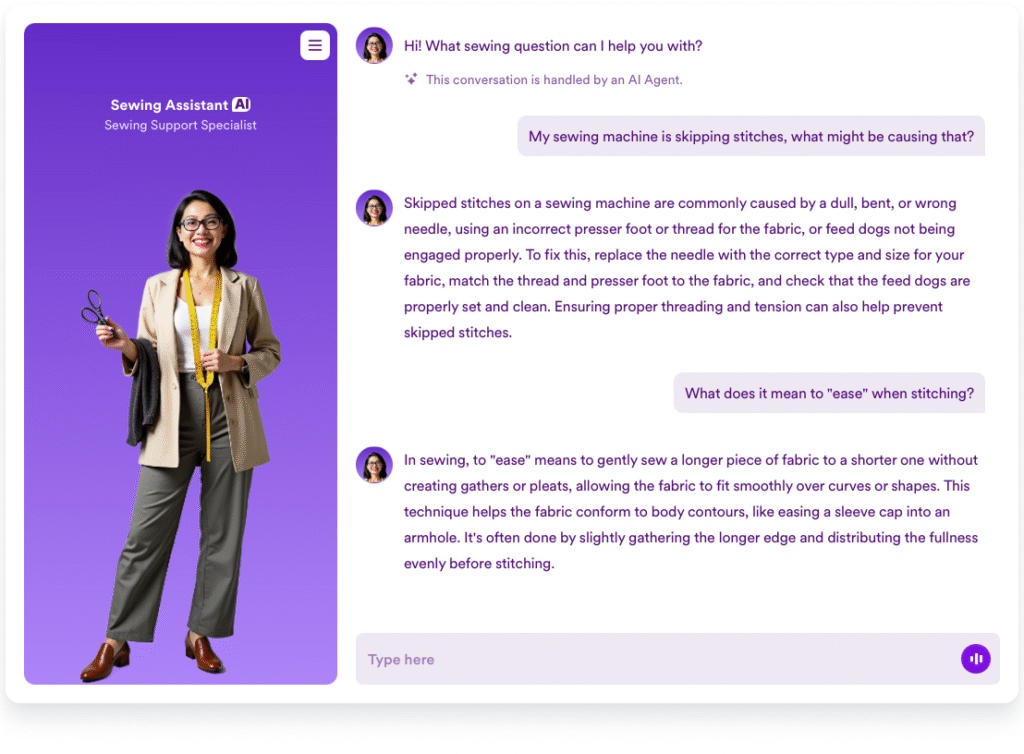
Your 24/7 Sewing Expert
The Sewing Assistant is your personal guide to everything sewing! Whether you’re just learning how to thread a machine or you’ve been sewing for years, this assistant is here to answer questions, explain techniques, and help you get the best results with every project.
Sewing can feel like a big world—with so many fabrics, stitches, tools, and techniques to explore. The Sewing Assistant breaks it all down into clear, simple steps, so you can focus on creating with confidence.
Yearly Subscription
Pay for a Year Upfront-
Sewing Assistant
-
Serger Assistant
👉 Subscribe today for as low as $9.99/month and start stitching with confidence!
What the Sewing Assistant Does for You
This assistant is trained on a wide range of sewing knowledge, including:
Sewing machine basics (threading, tension, stitch selection, maintenance)
Understanding stitches: straight, zigzag, stretch, decorative, buttonholes, and more
Fabric types and how to handle them (woven, knits, sheers, specialty fabrics)
Choosing the right needles, threads, and notions for your project
Garment sewing tips (seams, hems, zippers, darts, facings)
Home décor sewing (pillows, curtains, table linens, etc.)
Troubleshooting sewing machine problems and common mistakes
Helpful shortcuts, best practices, and time-saving tricks
Think of it as having a sewing teacher right by your side—ready to answer “how” and “why” in everyday language.
Ask Away for Expert Sewing Advice
What’s the best needle for sewing knit fabric?
Why does my thread keep bunching on the bottom?
How do I sew a zipper into a pillow cover?
What’s the difference between a seam finish and a hem?
Which stitch should I use for sewing elastic?
How do I adjust my machine tension for denim?
What’s the easiest way to sew a curved seam?
Can you explain how to make buttonholes?
Why is my fabric puckering when I sew?
How do I choose the right thread for lightweight fabric?

Q&A Examples
What does it mean to “ease” when stitching?
To “ease” when stitching means to gently and gradually sew a slightly longer piece of fabric to a shorter one without creating gathers or puckers. This technique allows the fabric to fit smoothly over curves or shapes, such as attaching a sleeve cap to an armhole. Easing provides a controlled amount of fullness for a better fit and shape in the garment.
Do I need a walking foot when stitching fabric with stripes?
While a walking foot is not strictly required when stitching fabric with stripes, it can be very helpful. A walking foot helps feed multiple layers of fabric evenly, which is especially useful for matching stripes accurately and preventing fabric shifting or puckering. Using a walking foot can make it easier to keep stripes aligned and achieve a professional-looking seam.
What type of thread is best when stitching denim?
The best thread for stitching denim is a heavy-duty thread, which is thicker and stronger to handle the tough fabric. Polyester or cotton-wrapped polyester threads are commonly used because they provide durability and strength needed for denim seams. Additionally, using a denim needle with a reinforced shaft will help prevent needle breakage while sewing through thick layers.
My sewing machine is skipping stitches, what might be causing this?
Skipped stitches on a sewing machine can be caused by several issues: a dull or damaged needle, using the wrong needle type for your fabric, poor threading or tension settings, or using old or low-quality thread. To fix this, replace the needle with one appropriate for your fabric, rethread both the top thread and bobbin, use high-quality thread, and check your tension settings. Ensuring the needle is inserted correctly and the machine is clean can also help prevent skipped stitches.
Is a serger better than a sewing machine?
A serger and a sewing machine serve different purposes, so one is not necessarily better than the other; they complement each other. A sewing machine is versatile for stitching various seams and tasks, while a serger excels at finishing edges, trimming fabric, and creating stretchy, professional seams quickly. If you want clean, durable seam finishes and work often with knits or stretchy fabrics, a serger is a valuable addition, but a sewing machine is essential for most sewing projects.
Yearly Subscription
Pay for a Year Upfront-
Sewing Assistant
-
Serger Assistant